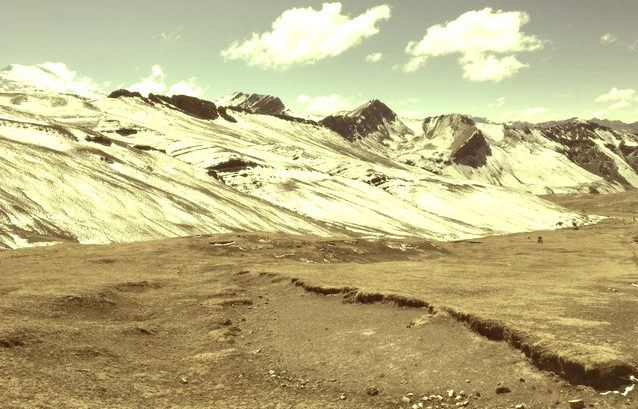FRANZ BISHOFF (1864-1929)
North Palisade (4,341 m - 14, 242 ft)
United States of America (California)
In Palisade Glacier, 1925, oil on canvas, Courtesy The Irvine Museum
The mountain
North Palisade (4,341 m - 14, 242 ft) is the third highest mountain in the Sierra Nevada range of California. It is the highest peak of the Palisades group of peaks in the central part of the range. It supports a small glacier (the Palisade Glacier) and several highly prized rock climbing routes on its northeast side.North Palisade has a collection of names from the 19th century. The Wheeler Survey referred to it as Northwest Palisade in 1878. The following year, Lil Winchell called it Dusy's Peak after local rancher Frank Dusy. In 1895, Bolton Brown advocated yet another name, after David Starr Jordan. U.S. Senator Dianne Feinstein, supported by U.S. Senator Barbara Boxer, has introduced legislation to rename the peak as Brower Palisade, in honor of environmentalist David Brower.
The North Palisade' first ascent was made on July 25, 1903 by James S. Hutchinson, Joseph Nisbet LeConte and James K. Moffitt.
North Palisade has several named subsidiary peaks. These all lie on the main ridge crest, and are as follows:
- Starlight Peak (4,328 m -14,200 feet ). This is the northwest summit of North Palisade, less than 0.1 mi (0.15 km) from the main summit. Some climbing routes end atop this peak known for its famous "Milk Bottle", a 20 ft (6.1 m) pillar of rock with huge exposure (class 5.6).
- Polemonium Peak (4,294+ m - 14,080+ ft) This lies between the "U-Notch" and "V-Notch" couloirs, 0.15 mi (0.25 km) east-southeast of North Palisade. Named on the USGS topographic map. The peak is named for the Polemonium eximium skypilot (plant) found in the area.
- Thunderbolt Peak (4,268 m- 14,003 feet ). About 0.25 mi (0.4 km) northwest of North Palisade. Named on the USGS topographic map. The Sierra Club guidebook notes: "This was the last 14,000 foot (4,267 m) peak to be climbed in the Sierra. During a wild storm on the first ascent, a bolt of lightning left Jules Eichorn severely shaken; hence the name".
The Palisade Glacier is located on the northeast side of the Palisades within the John Muir Wilderness in the central Sierra Nevada of California. The glacier descends from the flanks of four mountain peaks over 4,300 m (14,000 ft) in elevation of which North Palisade is third highest peak in the Sierra Nevada Range. The cirque containing the Palisade Glacier has a history of thousands of years of glaciation. The modern glacier attained its last maximum extent during the Little Ice Age, between 250 and 170 years ago (a period also known as the Matthes glaciation in the Sierra Nevada).
It currently has an area of .31 sq mi (0.80 km2) and the glacier is .81 mi (1.30 km) long and .50 mi (0.80 km) wide. It is located between 13,400 and 12,000 ft (4,100 and 3,700 m) and moves at a rate of 20 ft (6.1 m) per year, although it is also retreating.
Source:
The painter
Franz Albert Bischoff was an American artist known primarily for his China painting, floral paintings and California landscapes. He was born in Steinschцnau, Austria (now in Czech Republic).He immigrated to the United States as a teenager where he became a naturalized citizen. While in Europe, his early training was focused upon applied design, watercolor and ceramic decorations. After arriving in the United States, Bischoff worked in New York, Fostoria, Ohio, Detroit, Michigan and Dearborn, Michigan. While in Detroit and Dearborn, he gained success as a porcelain painter, and as a teacher of the techniques, as well as a manufacturer of ceramic glazes as well as a teacher of watercolor painting.
Franz Bischoff decided to visit California in 1900 and ultimately chose to settle in the Los Angeles area in 1906. Shortly after arriving, he started making arrangements to design and build a large Italian Renaissance style home in Pasadena that also became his studio. This landmark home was completed in 1908. Bischoff was one of the earliest members of the California Art Club, and the group's second meeting was held at his studio on February 5, 1910. Also present at that meeting were Carl Oscar Borg and William Wendt.
Inspired by the California countryside, Bischoff attempted to capture the area's brilliant light and diverse landscapes. Spending less time with ceramic painting following the start of World War I, Bischoff took up canvas painting. He painted local farms, fishing wharfs, coastal landscapes and scenes of the Sierra Nevada and the mountains of Utah, including Zion National Park. Recognized during his career for use of color and vivid composition, his paintings always displayed reverence for nature. One critic commented that some of his later works flirted with Expressionism and his use of colors were reminiscent of Fauvism. Franz Bischoff died of heart failure at home in his adopted city of South Pasadena, California on February 5, 1929.
Source:

























